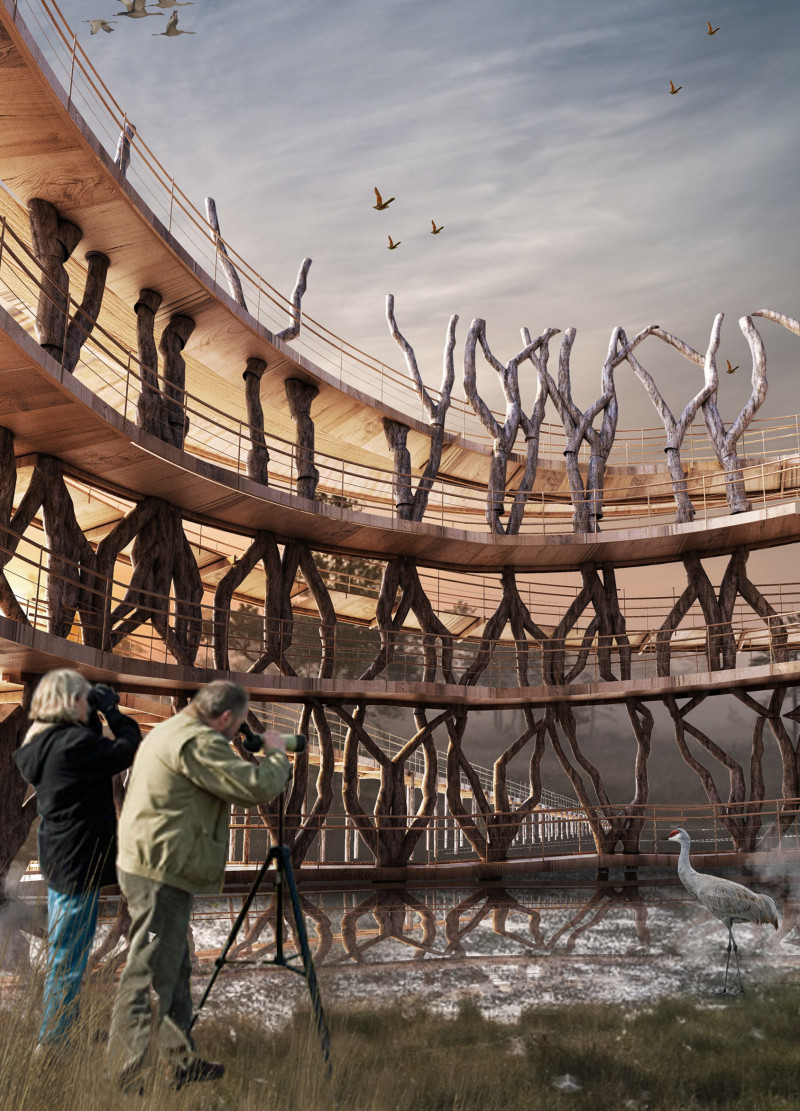5 key facts about this project
This project represents a thoughtful approach to architecture that prioritizes the relationship between humans and nature. By serving as an observation platform, the Kemeri Natural Tower facilitates wildlife observation, particularly avian species, allowing visitors to connect with the natural world on multiple levels. The structure is designed to enhance visitors' experiences, offering various observation points that provide immersive views of the park’s diverse ecosystems.
At the core of the Kemeri Natural Tower is its unique blend of form and function. The structure is built using natural logs and branches, elements that not only support the weight of the tower but also contribute to its aesthetic appeal. The timber framework is complemented by engineered wood panels that make up the flooring and observation platforms, ensuring a sturdy yet inviting environment. Additionally, transparent glass railings and observation windows enhance the visitor's experience by offering unobstructed views of the surrounding landscape.
One of the distinctive aspects of this project is its commitment to biophilic design principles. By creating spaces that encourage interaction with nature, the Kemeri Natural Tower fosters a deep appreciation for the local ecosystem. The varying levels of the observation tower are strategically designed to cater to both accessibility and aesthetic enjoyment, providing options for visitors with different mobility needs. This aspect of the design demonstrates a thoughtful consideration of user experience, making the tower inclusive and welcoming.
The creative layout of surrounding pathways and boardwalks further contributes to the overall user engagement with the landscape. These features are designed to minimize ecological impact while offering opportunities for exploration and education. Interpretive signage and guided tours can be integrated into the experience, enriching the knowledge of visitors regarding the local flora and fauna.
Sustainability is a significant focus in the construction and operation of the Kemeri Natural Tower. Utilizing locally sourced materials reduces the carbon footprint associated with transportation and construction processes. The structure not only serves as a recreational facility but also positions itself as a model for eco-tourism, promoting environmental stewardship among visitors. This educational component is vital in creating a culture of conservation and respect for nature.
Moreover, the design encourages community involvement and engagement. The tower functions as a hub for local initiatives, which may include environmental workshops, guided nature walks, and other activities that foster a community connection to the natural world. By promoting these interactions, the Kemeri Natural Tower underscores the importance of architecture in enhancing ecological mindfulness and community spirit.
In considering the unique design approaches utilized in this project, it is apparent that the Kemeri Natural Tower offers a compelling architectural prototype that highlights the potential for harmonious coexistence between built environments and nature. The thoughtful integration of sustainable practices, user-centered design, and community engagement make this project a relevant case study in contemporary architecture.
For those interested in a deeper understanding of this architectural endeavor, exploring the architectural plans, sections, and design ideas will provide valuable insights. Engaging with the full scope of the Kemeri Natural Tower presentation reveals the nuances of its construction and the thought processes behind its design, underscoring the project’s significance in the realm of sustainable architecture.


























